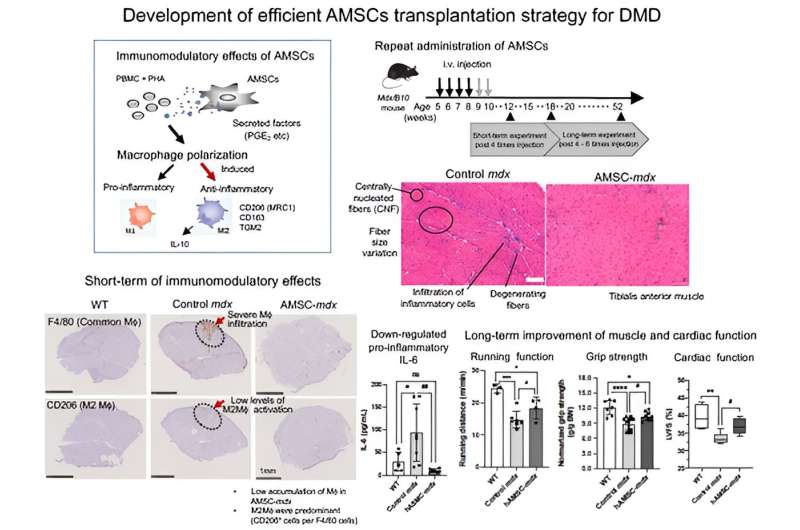This article has been reviewed according to Science X's editorial process and policies. Editors have highlighted the following attributes while ensuring the content's credibility:
fact-checked
trusted source
proofread
Novel stem cell transplantation strategy to treat Duchenne muscular dystrophy

Duchenne muscular dystrophy (DMD) is a common progressive muscular disorder. It is an X-chromosome-linked disorder that gradually weakens various muscle groups including those supporting the heart, thus resulting into early death. While steroids are widely used to regulate severe inflammation in patients with DMD, they are known to cause serious adverse effects.
In theory, the injection of mesenchymal stromal cells—supporting immune-regulation—can be used to slow down the progression of muscular dystrophy. However, its therapeutic effects require further investigation.
A recent study examined the effect of injecting human-amnion-derived mesenchymal stromal cells into DMD model mice. The results are quite promising and show long-term improvement of skeletal and cardiac muscle function in treated mice.
This paper was published in Stem Cell Research & Therapy. The research team included Prof. Takashi Okada and Dr. Yuko Nitahara-Kasahara from The Institute of Medical Science, The University of Tokyo; and Masahiro Hayashi and Tomoyuki Nakaishi from Kaneka Corporation.
"We focused on amnion-derived mesenchymal stromal cells (AMSCs), which have unique characteristics such as non-invasive isolation, mitotic stability, ethical acceptability, and a low risk of immune reaction," remarks Prof. Takashi Okada, from The Institute of Medical Science, The University of Tokyo.
AMSCs are known to exert immunomodulatory effects. Put simply, when intravenously injected into the target organism, they are able to suppress certain immune responses and also exhibit anti-inflammatory properties, thus making them ideal candidates for various therapeutic applications. Moreover, AMSCs are abundant in amnion, and they can be harvested using non-invasive techniques.
First, the research team isolated human AMSCs (hAMSCs) from amnion that were aseptically obtained from consenting pregnant women undergoing cesarean delivery. Next, they intravenously injected these hAMSCs into a DMD mouse model (mdx mouse) and studied their immunomodulatory effects.
They also analyzed the expression of anti-inflammatory M2 macrophage markers on peripheral blood mononuclear cells (PBMCs) co-cultured with hAMSCs. When systemically injected into the affected mice, hAMSCs secrete various factors influencing the polarization of macrophages, or specialized white blood cells, from the pro-inflammatory "M1" state to the anti-inflammatory "M2" state.
The team monitored the hAMSC-treated and untreated mdx mice using a variety of tests. These included standard blood tests, histological examinations, spontaneous wheel-running activities, assessment of grip strength, and echocardiography. Treatment with hAMSCs showed significant promise, especially when delivered during the early phase of DMD.
For instance, the proportion of anti-inflammatory M2 macrophages increased significantly in hAMSC-treated mdx mice. Quite notably, mdx mice that received the hAMSC treatment showed a better grip strength than the untreated mdx mice.
The treated mdx mice showed a transient downregulation of serum creatine kinase after repeated systemic hAMSC injections. "The downregulation of serum creatine kinase is usually associated with the suppression of muscle damage," comments Dr. Nitahara‑Kasahara.
The hAMSC treatment also resulted in the regulation of muscle damage following inflammation. In addition, it improved the histological appearance of the previously impacted skeletal muscles. Quite notably, the hAMSC-treated mdx mice also covered a greater distance per minute than their untreated counterparts during standard activity tests. Most importantly, the cardiac muscles of the treated mdx mice exhibited better functioning than those of the untreated mdx mice.
"This treatment strategy could provide therapeutic benefits to patients with DMD. This study is presumably the first to report the therapeutic benefits of AMSCs for severe muscular disease," says Prof. Okada. Although the published work still needs clinical translation, it nevertheless paves the way for a highly potent therapeutic intervention targeting DMD.
More information: Yuko Nitahara-Kasahara et al, Immunomodulatory amnion-derived mesenchymal stromal cells preserve muscle function in a mouse model of Duchenne muscular dystrophy, Stem Cell Research & Therapy (2023). DOI: 10.1186/s13287-023-03337-0


















